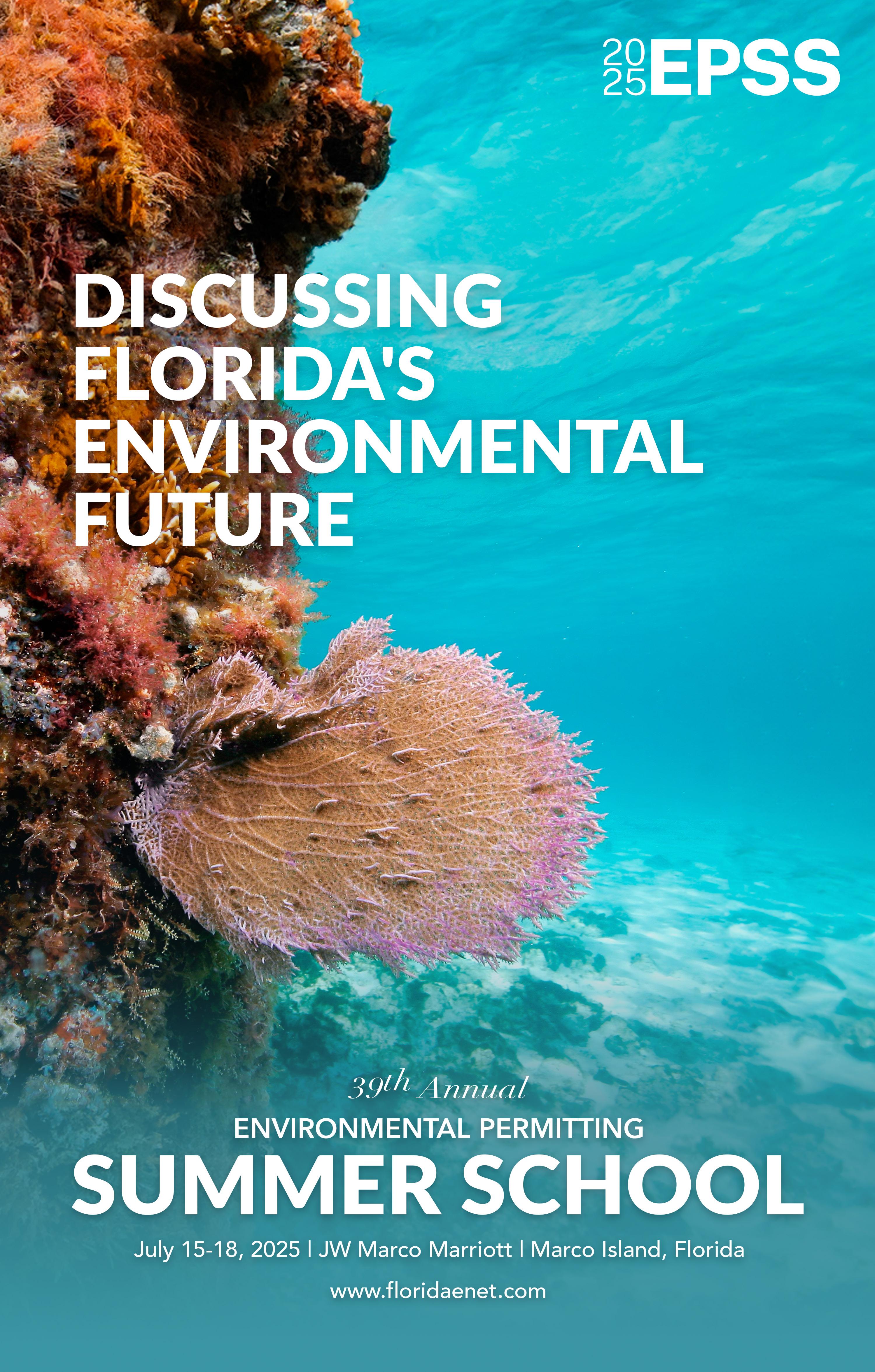
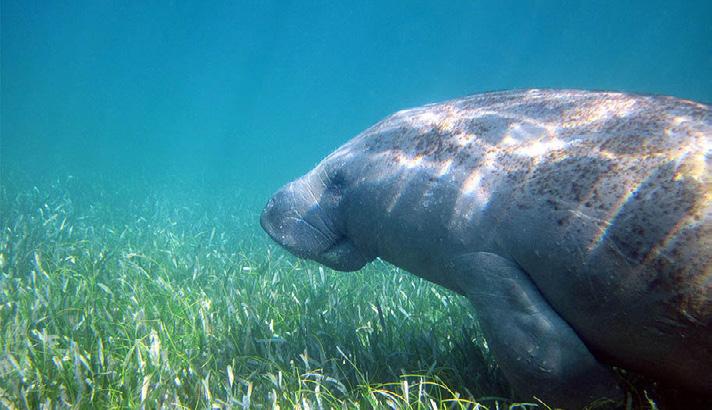
Florida's Environmental News Source of Record focused on news content of interest to the environmental community.



Florida's Environmental News Source of Record focused on news content of interest to the environmental community.
By BLANCHE HARDY
The U.S. Army Corps of Engineers (Corps) is relying on SES Energy Services LLC to process Clean Water Act Section 404 permits in Florida, following a year of court rulings that stripped the program from the State of Florida’s control.
Rockville, MD - When it comes to American cuisine, there are few things more iconic than steakhouses. The slabs of marbled meat, the sizzling grills, the oozing butter, and the dripping bravado, maybe even a cowboy hat or two for ambiance—it's enough to make even fictional steakophile Ron Swanson misty-eyed.
A federal court ruled in February that the Corps re-assume Clean Water Act Section 404 permitting regulating the discharge of dredged or fill material into waters of the United States, including wetlands, in Florida. The 404 Program was previously administered by the Florida Department of Environmental Protection (DEP). It has been out of their hands since the ruling.

Yet for all the traditional steak dinners ordered daily, there are restaurants nationwide pushing the concept of the all-American steakhouse to new culinary heights, according to market research firm Packaged Facts in the brand new report 2017 Forecast: Culinary Trend Tracking Series.
"The steakhouse is back and will capture our attention in 2017. Not that the classic restaurant style ever disappeared, but a renewal of the model is taking place in response to new sources of beef and new flavorful expressions of the concept that get chefs and diners excited," says David Sprinkle, research director, Packaged Facts.
Florida assumed responsibility for the program from the Corps on Dec. 22, 2020, after U.S. Environmental Protection Agency (EPA) approval of the state’s program. The court ruling is based on arguments EPA acted illegally when it transferred authority to the state. DEP filed an appeal of the decision in May. The Corps announced in July it would begin processing permit applications. DEP provided their files relating to pending Clean Water Act Section 404 actions to the Corps the same month

Address label change?
If your mailing label is inaccurate or incomplete, please contact us with the correct information at SPECIFIER PUBLISHING LLC, P.O. Box 1857 Tallahassee, FL 32302, or email us at admin@floridaspecifier.com. We appreciate your help with keeping our circulation database accurate.
Today's steakhouse menus increasingly feature grass-fed cattle, locally raised animals, heritage varieties, meat butchered and dry aged in-house, and dishes that stem from the whole animal, not just the premium cuts. And that's just the meat. Creative side dishes in lieu of old standards, global and seasonal flavors, and a wider menu selection also distinguish these new school operations.
Shawn H. Zinszer, Corps Jacksonville District Regulatory Division Chief, explained that the contract recently awarded to SES Energy Services LLC, “was initiated well before U.S. District Court for the District of Columbia vacated EPA’s approval of Florida’s application to assume the Clean

Water Act Section 404 program,” he said. “This contract has noth ing to do with that decision or its implementation. The contract is for assistance to all South Atlantic Division Districts and is limited to work on letters of permission, which are primarily used for docks in navigable waters, which are regulated under Section 10 of the Rivers and Harbors Act.”
Chefs and consumers both want their meat to taste delicious and to feel good about its’ consumption, too. This new breed of steakhouse broadcasts its mission to support local ranchers, factor in sustainability and animal welfare, and create a dining experience that showcases culinary flair, not just a grill master's skill at cooking steak to the requested doneness. These operations are also designed to be more inclusive, more of a great place for all kinds of people to dine well, not just traditionminded men on expense accounts. As a result, the modern steakhouse is increasingly similar to other modern restaurants with a focus on distinctive
Between Feb. 15 and Oct. 15, the Jacksonville Regulatory Division reports it has issued approximately 1,000 permits that are 404-related, in addition to other permits issued under other authorities. According to Zinszer, applicants have submitted applications for, and the Corps has issued permits for, a broad range of activities that vary in complexity and scope.
and sustainable sourcing, local and seasonal produce, and global flavors and forms, all done within the steakhouse format showcasing cuts of meat as entrées with a choice of sides. Moreover, new menu categories (such as flatbreads) and service elements freshen the concept.
The Corps noted that approximately 948 pending permits are being reviewed under the Corps Section 404 CWA authority. Some may subsequently be withdrawn. There may also be other pending actions that may require a Section 404 review.
Review is being undertaken by Corps staff in the Jacksonville District office in Florida and by 28 other Corps Districts and Technical Regional Execution Centers across the country. The Corps reported that there are approximately 200 project managers reviewing, evaluating, and processing Section 404 permit applications for activities in Florida as well.
About the Report 2017 Forecast: Culinary Trend Tracking Series offers an outlook on the culinary trends—the foods, dishes, ingredients and flavors—that Packaged Facts expects to grow in popularity in 2017.
By CHARLETTE ROMAN
Jacksonville, FL - After much anticipation and excitement, Jollibee, the largest Asian restaurant company, is now open in Jacksonville. This is the 36th store in the US, as well as
The South Florida Water Management District (District) is celebrating our 75th Anniversary this year! The District is highlighting our continued commitment to ensuring our regional flood control and water management system operates smoothly and efficiently to safeguard our water resources.
The District operates and maintains one of the largest flood control and water
been the talk of the town since 2016. With the opening, Floridians will get to try Jollibee's signature menu items such as the world famous Chickenjoy. This dish is delicately breaded to be crispylicious on the outside and juicylicious inside. The well-loved Jolly Spaghetti is a favorite of both kids and kids-at-heart because
management systems in the world. Central and Southern Florida’s regional system of canals, levees, pump stations and other critical infrastructure is vital to protecting water supplies and providing flood control for over nine million people.
In 1948, the U.S. Congress adopted legislation creating the Central and Southern Florida (C&SF) Project, the largest civil works project in the country. Construction began the next year and continued over 20 years as the U.S. Army Corps of Engineers


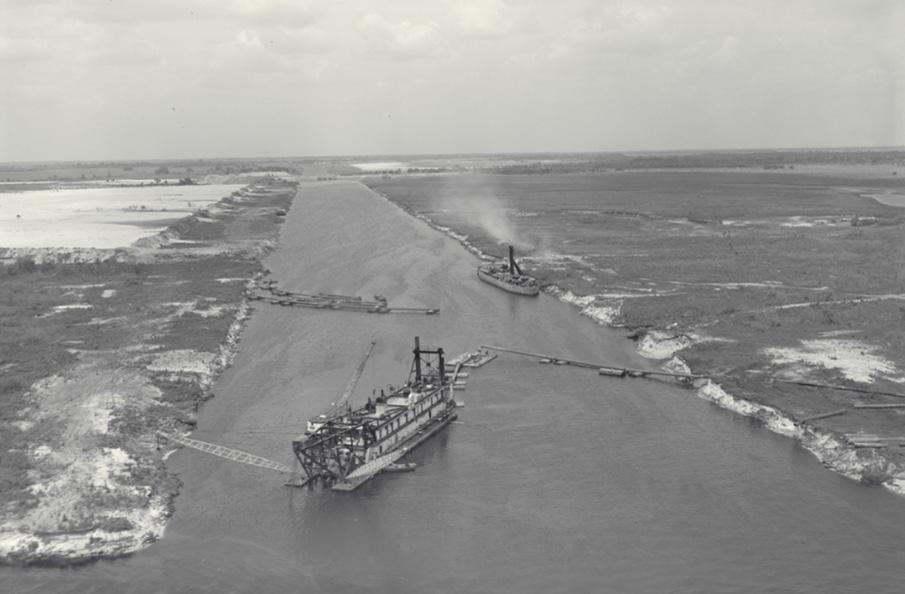
built the massive flood control plumbing system stretching from just south of Orlando to Florida Bay.
"As Jollibee debuts in Florida, we anticipate seeing not only a multitude of excited Jollibee patrons waiting to get their hands on their Jollibee favorites, but also first-timers waiting to have their own Jollibee experience," said Jose Miñana, Jollibee Foods Corporation's Group President for North America. "There's no greater joy for us than serving the needs and tastes of Jollibee fans in the community. At Jollibee, we aim to bring families together for happy moments over great tasting food with superior value, served with warm and friendly service – our own brand
On June 2, 1949, under Florida Governor Fuller Warren, the State Legislature created the Central and Southern Florida Flood Control District, the predecessor agency to the District, to manage the C&SF Project.
Today, 75 years after the creation of the Central and Southern Florida Flood Control District, the District continues to operate and maintain Central and Southern Florida’s regional water management system to effectively manage and safeguard our water resources, now and into the future. The flood control system moves approximately 20 million acre-feet of water per year.
The brand has become a symbol of nostalgia and warm childhood memories for many overseas Filipinos in the U.S. To many, Jollibee is the go-to restaurant of Filipinos for both special
JOLLIBEE page 15
Using state-of-the-art technology, District water managers monitor the weather around the clock to determine the optimal operation of hundreds of control structures located from Orlando to the Florida Keys. Our dedicated team of employees is working every day to manage and maintain:
• 2,175+ miles of canals
• 2,130+ miles of levees/berms
• 915+ water control structures
By PATRICK GILLESPIE
The U.S. Fish and Wildlife Service filed a proposed rule in September to revise the critical habitat designation for the Florida manatee, “based on the physical or biological features essential to the conservation” of the state’s official marine mammal.
Manatees are protected by the Marine Mammal Protection Act of 1972, the Endangered Species Act of 1973, and the Florida Manatee Sanctuary Act of 1978. It is illegal to feed, harass, harm, pursue, hunt, shoot, wound, kill, annoy, or molest manatees, according to the Florida Fish and Wildlife Conservation Commission (FWC).
“Manatees have waited nearly 15 years for the Fish and Wildlife Service to fulfill its promise to update these lifesaving habitat protections, so this is a big win for the species,” said Ragan Whitlock, a Florida-based attorney at the Center for Biological Diversity. “Officials recently resorted to emergency feeding trials to try to keep these animals from starving to death from seagrass declines. Truly protecting the manatees’ home, including their seagrass food source, is the most important step on their road to recovery.”
The U.S. Fish and Wildlife Service (FWS) will accept comments on the proposed rule on or before 11:59 p.m. EST on Nov. 25. The proposed rule also affects habitat for the Antillean manatee, which is primarily found in the Caribbean.
According to the News Service of Florida, the proposal came after the Center for Biological Diversity, Defenders of Wildlife and the Save the Manatee Club filed a lawsuit in 2022 to try to force upgraded habitat protections. The federal agency later reached a settlement and agreed to propose revised critical habitat for manatees by this month.
“For too long, we have degraded and destroyed the Florida manatee’s habitat through pollution, dredging and blocking access to the natural warm water springs vital to its winter survival,” Jane Davenport, a senior attorney at Defenders of Wildlife, said in a prepared statement.
“When finalized, the proposed critical habitat expansion will give federal, state
and conservation groups the information and impetus to ensure the beloved Florida manatee’s full recovery.”
As part of its rule filing, the U.S. Fish and Wildlife Service proposes twelve areas that would be included as critical habitat units, totaling nearly 2 million acres of public and private owned land in throughout the state. In 1976, the federal government designated 965,394 acres of critical habitat for the Florida manatee.
The areas are:
• Wakulla Springs
• Manatee and Fanning Springs
• Withlacoochee Bay to Anclote River
• Tampa Bay
• Venice to Estero Bay
• Rookery Bay to Florida Bay West
• Upper Florida Keys
• Biscayne Bay to Deerfield Beach
• Boynton Beach to Fort Pierce
• Vero Beach to Northern Indian River Lagoon
• Upper St. Johns River
• Silver Springs
According to the federal agency, the twelve units are proposed for designation based on one or more of the physical or biological features being present to support the Florida manatee’s life-history processes. Some units contain all of the identified physical or biological features and support multiple life-history processes. Some units contain one or more of the physical or biological features necessary to support the subspecies’ particular use of that habitat.
Seagrass die-off as a result of pollution and boating pose dangers to the manatee, also called the sea cow. According to FWC, 555 manatees died in 2023 and 475 have died through Oct. 11 in 2024. These numbers are lower than the prior years, as 1,100 manatees died in Florida waters in 2021 and 800 in 2022. ●
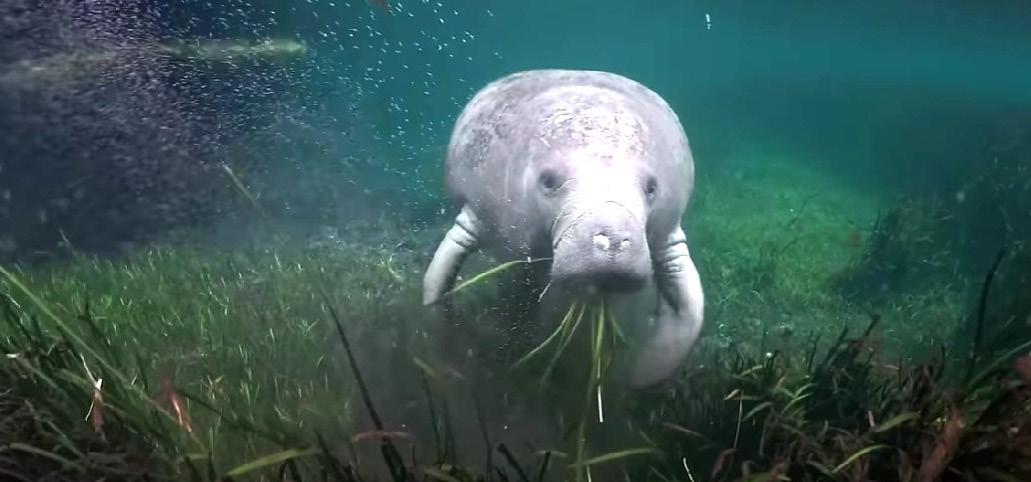

Applications are screened in the order they are received and are all assigned in a uniform manner, said Zinszer. Tasks are incorporated into the project managers’ existing review. Review time depends on the purpose, work, activities, impacts, complexity, resources, and any special circumstances specific to that application.
The Corps has received and is utilizing the environmental and technical information developed through FDEP’s processes.
“USACE must independently evaluate such information and comply with all applicable federal laws and regulations,” Zinszer said. “Many of the application packages USACE has received from FDEP do not contain the minimum information required for a complete application or for USACE to complete its evaluation. We continue to work with the applicants and their agent/consultant to ensure that the information provided meets all Federal requirements.” ● FROM 404 UPDATE ON 1


ROMAN South Florida Water Management District DANIELLE FITZPATRICK St. Johns River Water Management District EMILY ABELLERA Florida Fish & Wildlife Conservation Commission KEYNA CORY Florida Recycling Partnership Foundation KEVIN DOYLE Consumer Energy Alliance NORWIN VOEGELI Global Ingress
The Florida Specifier (ISSN 07401973), founded in 1979, is published every other month for $60 per year in-state; $80 out-of-state, by SPECIFIER PUBLISHING LLC, P.O. Box 1857, Tallahassee, FL 32302. Subscription refunds are not provided. Local tax applies.
POSTMASTER: Send address changes to the FLORIDA SPECIFIER, P.O. Box 1857, Tallahassee, FL 32302.
© Copyright 2024 by SPECIFIER PUBLISHING LLC. All rights reserved. No part of this publication may be reproduced or transmitted in any form without the publisher’s prior written permission.
Florida Specifier P.O. Box 1857
Tallahassee, FL 32302 Admin@FloridaSpecifier.com
By PATRICK GILLESPIE
The Florida Legislature’s long break from action returns in November for a one-day organizational session, followed by its annual interim committee weeks schedule.
On Nov. 19, members will meet for a oneday organizational session, where officers will be selected, and each chamber will begin organizing for interim committee weeks. For many new members following the Nov. 5 election, it will be their first introduction to legislative service.
During interim committee weeks, which will be sporadically scheduled between December and February, legislators will begin hearing policy bills, file budget requests, hear presentations from state agencies about their key projects and programs and updates on the status of 2024 legislative session bill implementation, as well as discussions on key policy topics.
These weeks also represent new leadership in both chambers. Senate President Kathleen Passidomo will end her term as President this November, turning the role over to Sen. Ben Albritton, who will serve as President for the next two years. Speaker Paul Renner will turn over the gavel to Rep. Daniel Perez of Miami.
Albritton, of Wauchula, has said he will focus his time on the state’s agriculture.

38TH ANNUAL NATIONAL CONFERENCE ON BEACH PRESERVATION TECHNOLOGY
When: Feb. 5-7, 2025
Where: Embassy Suites, Panama City Beach
Conference objectives are to present the latest in beach preservation technology and real-world practice and to provide a technological transfer from the scientific and engineering community to government officials who make the decisions on coastal projects and policies.
https://www.fsbpa.com/ tech-conference.html
CLIMATE CAFE SERIES - A BRIGHT LIT PLACE, PART 2 | MIAMI, FL OR VIRTUAL
When: Nov. 13 4 p.m. reception 4:30 program
A Bright Lit Place, Part 2: Thirty years later from the planning and approval by congress to proceed, this session will explore where we are today, how we got here, and breakdown what was promised and is still being delivered. How has climate change and sea level rise impacted the plan’s timeline and factored into the overall goal for sustainable restoration of the Everglades and South Florida?
Ben Kirtman, Ph.D.
“My nights in our family’s groves were romantic in a way,” Albritton said during his designation ceremony in 2023. “They helped me develop a lifelong, legitimate love for
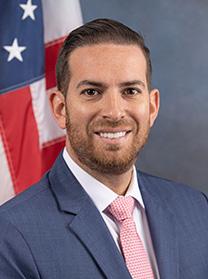
Florida agriculture. It’s in my blood now… it’s part of what drove me to public service. I know firsthand what it takes to produce the food that feeds our state, our country and the world. If you really stand back and think about it: the survival of agriculture is the survival of humanity.”
“Faith, family, freedom, opportunity in life are indeed the values that define me. But agriculture is a big part of who I am, too,” said Albritton. “I am a product of Florida’s heartland – a place with wide open spaces, beautiful landscapes, gorgeous creeks and rivers, rolling sand hills and small, close-knit towns. A lengthy list of crops are grown there.”
Perez, who is an American of Cuban descent and grew up in Miami-Dade County, used his designation ceremony to speak about the dangers of socialism. He spoke of being influenced by the stories of family members who talked of the fear
William R Middelthon III
Colonel Terrence "Rock" Salt
Evelyn Gaiser, Ph.D.
https://www.eventbrite.com/e/the-climate-cafe-series-tickets-1007961268287?af f=oddtdtcreator
FLORIDA ONE WATER SUMMIT
When: Nov. 18-19
Where: Nora Mayo Hall, Winter Haven
Join executives across the region for a twoday summit to explore the state of Florida's One Water strategy including current status and the challenges of water resources; the future of managing water resources; one water projects and initiatives; and establishing a one water culture.
https://stg.flonewatercommission.wspis.com/
AMERICAN WATER WORKS ASSOCIATION FLORIDA SECTION 2024 FALL CONFERENCE
When: Dec. 8-11
Where: Omni Orlando Resort at Championsgate
The conference is a fantastic opportunity to stay updated on the latest advancements in water technology! Technical sessions offering CEUs and PDHs are an excellent chance for professional development.
The Exhibit Hall will be informative, with over 180 booths showcasing new products and services. Also, find time to attend networking events to connect with peers and industry representatives.
https://site.pheedloop.com/ event/FSAWWA24/home

they felt from unchecked government leaders.
“They knew that power without restraint leads to tyranny just as freedom without responsible results in anarchy,” he said. “I believe in limited government because history has taught us what happens when people in power
begin to think they know more than the people who gave them their power.”
He spoke about the importance of leaders in Tallahassee using restraint in creating legislation, focusing on all people and just not just the powerful.
“Just because we have the power to do a thing doesn’t necessarily mean that we should,” he said. “Just because we think we are right doesn’t mean we are justified.”
Interim committee weeks begin the first week of December and will end the third week of February. The 2025 Florida Legislative Session will begin March 4. ●
When: March 16-19, 2025
Where: JW Marriott Tampa
2025 marks the 40th anniversary of the WateReuse Symposium! In 1985, water professionals first convened in San Diego to discuss emerging water reuse technologies and strategies. Today, water reuse drives prosperity, sustainability, and public health for communities worldwide.
The Annual WateReuse Symposium is the premier conference on water recycling — attracting water professionals and water reuse practitioners globally for knowledge-sharing, networking, and collaboration. The Symposium is the most comprehensive water recycling learning opportunity available, covering policy, technology, operations, and communications for applications that range from irrigation and potable reuse to onsite and industrial systems.
https://watereuse.org/news-events/conferences/symposium-2025/
When: May 4-7, 2025
Where: Palm Beach Convention Center
This forum is for presentations and discussions of cutting-edge technology development as well as practical case studies of applications of technology in water and wastewater utilities. The conference is unique in that it brings together a broad range of professionals: engineers, scientists, operators, technicians and management, of all water utilities. The FWRC also features one of the largest regional technical exhibitors in the nation with the participation of over 350 manufacturers and services providers.
FWRC is a joint conference of the Florida Section of the American Water Works Association, the Florida Water Environment Association, and the Florida Water and Pollution Control Operators Association.
https://www.fwrc.org/

By EMILY ABELLERA
Earlier this year, NOAA Fisheries awarded the Florida Fish and Wildlife Conservation Commission (FWC) three Exempted Fishing Permits (EFP) to conduct three unique red snapper studies, enabling the agency to collaborate with anglers, test innovative ways to reduce discards, increase harvest opportunities, and improve angler satisfaction.
EFPs are permits that allow harvesting for specific purposes that are otherwise prohibited under current federal regulations. In these studies, some participants will be selected to catch and keep red snapper during a time that works for participants. And FWC is seeking applications now.
The three studies of this project take place off Florida’s east coast from the Florida/ Georgia line south to the Dry Tortugas. Two studies, the FWC Study Fleet and the FWC Hot Spot Fleet, are conducted from the Florida/Georgia line south to

Cape Canaveral. The third study, the FWC Southeast Florida Snapper Grouper Fleet, is conducted from Cape Canaveral to south of the Dry Tortugas.
Each study is somewhat different, but all focus on testing alternative management strategies to reduce discards, improving reporting of catch and discard information via an FWC app, improving best fishing practices and fish identification through an FWC education course, and evaluating
angler satisfaction of EFP participants relative to those who must abide by federal regulations.
The projects will occur simultaneously over 12 months, starting in August 2024 and running through July 2025. The project duration is broken up into four threemonth quarters to allow the most harvest opportunities for anglers along the east coast of Florida. The application period for each quarter will open the month prior.
Quarter 1: August 2024 to October 2024
Quarter 2: November 2024 to January 2025
Quarter 3: February 2025 to April 2025
Quarter 4: May 2025 to July 2025
The FWC believes this collaboration has the potential to improve fisheries management in the South Atlantic. Florida’s recreational saltwater anglers are encouraged to
apply to participate. More information is available at MyFWC.com/AtlanticEFP
How to Apply
Applications for Quarter 2 recently closed, and the next application period for all projects for Quarter 3 will be January 3-13.
FWC Hot Spot Fleet and FWC Southeast Florida Snapper Grouper Fleet Projects: Applicants must apply at GoOutdoorsFlorida.com. Participants will be selected via lottery. Watch a video tutorial on how to apply.
FWC Study Fleet: Applicants must complete the Study Fleet online application form, which will go live during the open application period. All applications will be reviewed according to Study Fleet criteria prior to selection. ●
Emily Abellera is Public Information Coordinator at FWC
By LINA ALFIERI STERN
Within two weeks in late September and early October 2024, hurricanes Helene and Milton wreaked havoc across Florida, leaving significant environmental and infrastructural challenges in their wake. As efforts continue to recover from the wind and flooding damage these storms brought, the full environmental impact is not yet known.
Hurricane Helene made landfall on Sept. 26, followed by Hurricane Milton on Oct. 9. Highlighting the severity of their effects, Hurricane Milton alone knocked out power for more than 3 million customers and triggered around 150 tornado warnings. The Atlantic hurricane season runs from June 1 to Nov. 30.
The storms did not just disrupt everyday life; they also exposed vulnerabilities within critical infrastructure. From Tampa to St. Petersburg to Lakeland, dozens of municipal wastewater systems in the path of the hurricanes failed, spilling millions of gallons of wastewater into public waterways. According to Rice University’s Center for Coastal Futures and Adaptive Resilience Toxic Release Inventory (TRI), there were 2,200 TRI facilities in Helene’s cone of impact and 694 in Milton’s, which represent facilities that process more than 142 million and 26 million pounds, respectively, of hazardous materials per year.
Tampa reported discharging 8.5 million gallons of sewage from ten overflows, all along the Hillsborough River and the south Tampa coastline, according to news reports.
Flooding in the Apollo Beach and Ruskin communities caused damage to wastewater pumping systems in south Hillsborough County. Backup generators limited the damage that would have been caused by loss of power, but some pumps were damaged due to electrical shortages.
St. Petersburg’s overwhelmed infrastructure during Hurricane Helene resulted in the discharge of nearly 1.5 million gallons
of untreated wastewater throughout the area, according to the Tampa Bay Times. Approximately two-thirds of this pollution originated from the Northeast Water Reclamation Facility, which began leaking on the night of Sept. 26. The facility, which typically processes 8 to 10 million gallons of sewage daily, was offline for at least 48 hours, affecting a quarter of the city’s population. In addition to this major discharge, six other incidents of untreated wastewater occurred in the area, releasing approximately 220,550 gallons into local waterways.
St. Pete Beach City Manager Fran Robustelli reported that the town’s sewer system faced significant challenges during the hurricanes stemming from equipment failures, namely the 21 lift stations that transport wastewater to the treatment plant in St. Petersburg. During Hurricane Helene, storm surges damaged control panels at eight of these stations, rendering them inoperable. Hurricane Milton further aggravated matters by causing utility power loss at all lift stations. Nine lift stations require repairs, with construction expected to take approximately 18 months.
The Lakeland district documented at least eight spills impacting Lake Somerset, Lake Parker, Lake Hollingsworth, Lake Bonny, Lake Bentley, and the Lake Hunter Outfall Ditch. The two most significant spills occurred at the Glendale Wastewater Reclamation Facility in southeast Lakeland, which has been in operation since 1926, and together accounted for five million gallons, according to reports filed to the Florida Department of Environmental Protection.
Little is yet known about the full environmental consequences of the hurricanes on industrial facilities. Hurricane Helene’s storm surge flooded the retired Crystal River nuclear power plant operated by Duke Energy. Rising waters inundated the site, including its buildings and wastewater facilities, raising concerns about low-level radioactive waste and the potential impact of flooding, especially in light of a similar incident after Hurricane Idalia in
2023. While Duke Energy reassured the public that used nuclear fuel is securely contained, the facility is set to hold spent fuel until 2037.
The Mosaic Company reported a pollution spill into Tampa Bay during Hurricane Milton. Heavy rainfall overwhelmed the company’s collection system at its Riverview phosphate mine, leading to an escape of excess water through a manhole. The leak exceeded the 17,500-gallon minimum reporting threshold, although the company did not specify the exact volume. Florida is home to 25 phosphogypsum plants, which together house more than 1 billion tons of a solid waste byproduct from phosphate fertilizer mining. This byproduct contains radium, which decays into radon gas, and is associated with cancer risks.
While organizations such as Rice University’s Center for Coast Future’s and Adaptive Resilience (CFAR) track the locations of industrial facilities in the path of hurricanes (see CFAR Interactive Map), they are unable to get real-time data on the impact of natural disasters and other disruptive events to those facilities.
“Companies do not always disclose spill data,” said CFAR’s Co-Director Dr. Dominic Boyer. “Our tool helps to make risks more visible, but we don’t have a way yet of tracking damages.”
Many facilities are not required to disclose their risks, and the U.S. Environmental Protection Agency (EPA) mandates only general details in risk management plans, which can be difficult for the public to access. Furthermore, many states, including those along the Gulf Coast, often relax pollution restrictions during emergencies, and notifications of chemical incidents are frequently delayed.
As Florida grapples with the aftermath of hurricanes Helene and Milton, the intersection of severe weather, environmental safety, and infrastructural integrity remains a pressing concern. Understanding the full impact of these storms on sensitive sites and communities will be crucial for future preparedness and resilience efforts. ●


By DANIELLE FITZPATRICK
In Florida, storm season is a way of life, and with it comes the challenge of unpredictable flooding. But what if we could see flood risks coming before a storm hits? Imagine the difference it could make for communities to know where water might rise — well ahead of time. Thanks to new technology, that vision is becoming a reality.
The St. Johns River Water Management District, in cooperation with Streamline Technologies, has developed a Real-Time Flood Forecasting Resiliency Model for the Upper St. Johns River Basin (Indian River, Brevard, and portions of Okeechobee, Osceola, Orange, Seminole and Volusia counties), an area covering 1,300 square miles. This model can provide forecasts of water levels up to 10 days in advance. Using a blend of geospatial, weather and water data, it helps predict how storms will impact water levels across the region.
“The model has the capability to operate on multiple scales, from large regional areas to showing how a particular storm may affect a small community,” said the District’s Bureau Chief of Watershed Management and Modeling Yanbing Jia. “We will be able to share this data with local governments and emergency managers to help them respond to flooding events.”
With the completion of the Upper St. Johns Basin model, the District is now working to expand its forecasting capabilities to central Florida, a region that faces unique flooding challenges. Unlike faster-flowing rivers, the slow-moving St. Johns River often causes floodwaters to linger, especially after major storms like hurricanes Ian and Nicole, which led to record flooding in recent years that severely impacted local communities.
“In the aftermath of those storms, the District brought together city, county and state agencies to brainstorm better ways to predict, manage and respond before and after a storm event,” said the District’s Chief Resilience Officer Tom Frick. “From that meeting, it became clear that there was a real need for flood forecasting in the central Florida area followed by collective action.”
In 2024, the District received a Resilient Florida Program Planning Grant to help expand the flood forecasting model across the 2,900-square-mile Upper and Middle St. Johns River Basin (portions of Orange, Seminole, Volusia and Lake counties). Managed by the Florida Department of Environmental Protection, the Resilient Florida Program funds projects that enhance climate resilience across the state.
This grant will allow the District to collect additional data and develop improved
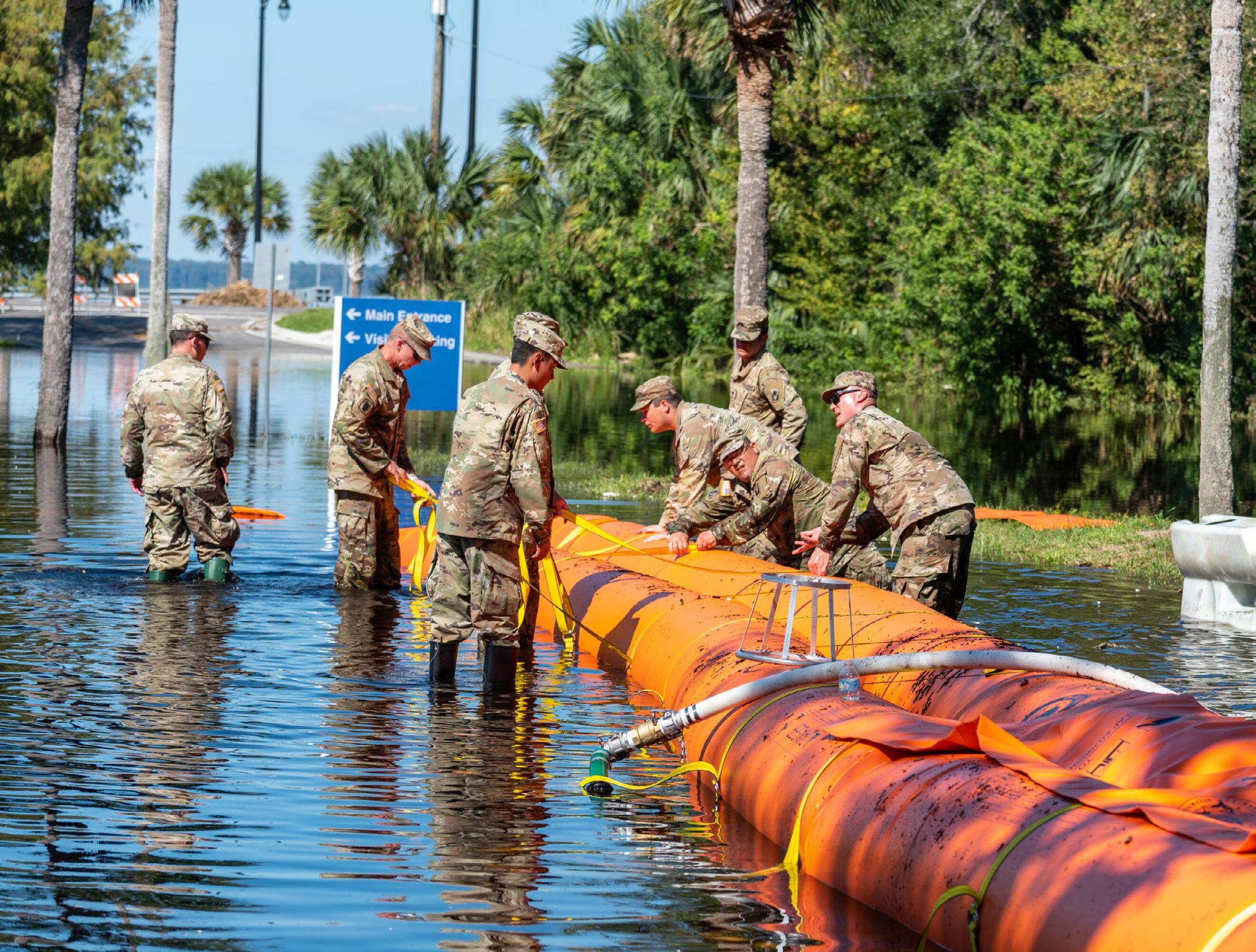
tools to provide more precise flood predictions across a larger area.
Part of this expansion involves working closely with local governments to map out flood-prone areas and integrate their existing stormwater models with the District’s forecasts. By doing so, local emergency teams will have more accurate and timely information on water levels and flood risks, helping them prepare and respond faster when storms hit.
The District is also collaborating with the Florida Flood Hub, which connects scientists, policymakers and the public to improve flood risk management across the state. Sharing data with the Flood Hub will help strengthen flood forecasting and inform science-based policy and planning statewide.
This expanded, comprehensive flood forecasting model is expected to be completed by August 2027. While existing systems already help guide flood management before and after storms, the new model will provide communities across the region with even better tools to predict and respond to flood risks, ultimately making neighborhoods safer and more resilient. ●
Danielle FitzPatrick is a Public Communications Coordinator at the St. Johns River Water Management District


structure
River Water Management
water management


Siting improvements including solar investments and energy conservation, Duke Energy Florida recently requested to lower rates and decrease customer bills in January 2025. The request is part of an annual adjustment for the cost of fuel used to generate electricity at the company’s power plants.
If approved by the Public Service Commission, typical residential customers using 1,000 kilowatt-hours (kWh) will see a decrease of $9.77 on their January 2025 bill when compared to December 2024. Duke Energy Florida has already reduced rates twice this year – once in January and again in June. Residential customers pay roughly $17 per 1,000 kWh less today when compared to one year ago.
“Duke Energy is consistently looking for creative ways to reduce rates and provide financial relief to our customers,” said Melissa Seixas, Duke Energy Florida state president. “We work to deliver real value, including a stronger, more reliable grid and cleaner energy.”
Duke proposes to decrease Florida residential rates by approximately 6 percent, while making grid improvements to enhance reliability, security and resilience in 2025 and beyond. Rates for 2025 reflect investments resulting in fewer outages and shorter restoration times, as well as solar investments. It also includes Duke Energy Florida’s annual capacity, energy conservation, storm protection plan and environmental compliance clause costs. Commercial and industrial customers will also see bill decreases ranging from 5.1 to 11.1 percent, depending on several variable factors.
The 2025 rates also reflect the comprehensive agreement reached between Duke Energy Florida and customer representatives. The agreement increases reliability and advances the clean energy vision for the state, while focusing on ways to assist and pass on savings to customers. ●

“This approval demonstrates our commitment to working with stakeholders to ensure that we can continue to deliver safe, reliable and clean energy to our customers for decades to come,” said Armando Pimentel, FPL president and chief executive officer. “Turkey Point is an integral part of the local economy and an essential part of FPL’s fuel mix.”
The Turkey Point Plant is located 25 miles south of Miami. The facility occupies 11,000 acres of land dominated by protected mangrove swamps and 168 linear miles of cooling canals. Unit 3 began commercial operation in 1972, followed by Unit 4 in 1973. The active units generate sufficient energy to power the equivalent of nearly 1 million homes and businesses and play a pivotal role in maintaining grid stability.
According to FPL, Nuclear power plants have one of the lowest impacts on the environment of any energy source as they produce zero carbon emissions. Nuclear power comprises 20 percent of the company’s fuel mix and is the second largest energy source in Florida. The facility preserves habitat supporting Florida’s threatened American crocodile and other native species.
“This approval is the culmination of rigorous efforts to meet and exceed regulatory expectations,” said Turkey Point Site Vice President Mike Strope. “Our team demonstrated exceptional dedication and expertise throughout the reapplication process, ensuring that the safe and reliable operation of Turkey Point continues to play a critical role in supplying zero-emissions electricity to FPL customers.” ●

UF/IFAS:Fallen Trees can Reveal Hidden Termites
Thomas Chouvenc, associate professor of urban entomology at the UF/IFAS Fort Lauderdale Research and Education Center, is warning homeowners to be vigilant about fallen trees now more than ever, some of which may have already been damaged by termites before the recent storms. Fallen trees with unusual damage can also reveal the presence of invasive subterranean termites within the surrounding areas of a home.
“This hurricane season in Florida has proven to be more challenging than in years past, with intense wind speed and floods. Unfortunately, Florida is also facing mounting termite pressure with the spread of major invasive pest species in many urban areas across the state,” he said. “While hurricanes pose a direct threat to trees and structures, the hidden damage caused by invasive termites can make the situation worse.”
when wind speeds would normally not be enough to cause the damage.
“After a storm, we often see trees on roofs and cars, but many of these trees would have withstood the storm had they not been compromised by termites,” said Chouvenc “In areas where these two invasive termites have established for years, it is essential to inspect trees regularly for termite mud tubes. Regular tree inspections can help detect early termite infestations, allowing for treatment before the damage becomes extensive.
The UF/IFAS termite distribution map provides up-to-date information on where the primary invasive termite pest species are located across the state. Residents are encouraged to check the map to determine their risk and take necessary precautions, including inspecting and treating trees in their yards. ●
EPA Region 4 in September proposed to issue a Consent Agreement and Final Order, assessing an administrative penalty of $70,500 to AgReserves, Inc., operating as Deseret Cattle and Timber,
The order will settle the EPA’s allegations that Deseret discharged dredged and/or fill material into approximately 809 acres of jurisdictional wetlands and waters of the United States using earth moving machinery during unauthorized activities associated with the development of pine tree silviculture areas into cattle pastures and the construction of stock ponds generally located east of Callaway, north of East Bay, west of Sandy Creek, and south of State Route 22 in Bay County. The release is in violation of Section 301(a) of the Clean Water Act, 33 U.S.C. § 1311(a). ●
Miami-Dade County Removes 500th Derelict Vessel
The Department of Regulatory and Economic Resources’ Division of Environmental Resources Management (RER-DERM) recently removed its 500th derelict vessel from Biscayne Bay. The effort is part of the Marine Debris Removal and Prevention Program.
“Derelict vessels and marine debris pose a serious threat to the health of Biscayne Bay because they release pollutants into the water, damage marine life, threaten boater safety and cost Florida taxpayers millions of dollars each year in removal and disposal,” said Miami-Dade County Mayor Daniella Levine Cava. “By reaching this milestone, we are taking a significant step toward preserving the beauty and health of Biscayne Bay, which is not only a
critical part of our ecosystem but also vital to our economy and quality of life.”
The 500 vessels were removed from a variety of coastal areas from Maule Lake to Manatee Bay, from the Oleta River to the Miami River, and throughout Biscayne Bay. If collected in a line, the vessels would stretch over 2.55 miles (approximately 13,490 feet) end-to-end, about the distance across the Bay from the mainland to Miami Beach.
RER-DERM partners with the Florida Fish & Wildlife Conservation Commission (FWC) and other marine law enforcement agencies to document and remove derelict vessels. The program is funded by the Florida Inland Navigation District (FIND), the Florida Fish and Wildlife Conservation Commission (FWC), and the Biscayne Bay Environmental Enhancement Trust Fund. ●
Tampa’s City Center Achieves U.S. Green Building Council LEED Gold for Sustainability
The City of Tampa’s City Center at Hanna Avenue announced that the U.S. Green Building Council (USGBC) has awarded City Center gold-level LEED certification. Leadership in Energy and Environmental Design (LEED) is a green building certification program used worldwide to help create more environmentally friendly spaces.
City Center was originally a brownfield site with a warehouse, the clean up ahead of City Center’s construction ultimately resulted in the site being removed from the brownfield list. “
Home of the first publicly available electric vehicle charging stations in East Tampa and the largest rooftop solar project in the entire city, City Center at Hanna Avenue proves our commitment to our environment and our people,” said Mayor Jane Castor. “Sustainability, resilience, and equity are deeply woven into this project, and many others we have in the pipeline, to ensure we are Transforming Tampa’s Tomorrow in a sustainable way.”
LEED Principles at the City Center include, 27 electric vehicle charging stations and reserved spaces for green vehicles, bicycle storage, coupled with ADA-accessible shower and changing rooms to promote bicycle commuting, 30 percent (144,400 sq. ft.) of open space of which 75 percent is landscaped with native plants, a 35 percent reduction in indoor water use, using low-flow faucets, toilets, and shower heads and a 50 percent reduction in outdoor water use, using native plants and efficient irrigation techniques, and over 1 megawatt of on-site solar as well as other green achievements. ●
FPL’s Turkey Point Nuclear Power Plant Authorized to Operate for Another 20 Years
The U.S. Nuclear Regulatory Commission (NRC) has approved the subsequent license renewal for Florida Power & Light Company’s (FPL) South Florida Turkey Point Nuclear Power Plant Units 3 and 4, enabling the continued operation of these units through 2052 and 2053, respectively.
Trees that have been compromised by termites may appear healthy, but their internal structure could be weakened, making them more vulnerable to storm damage.
Two invasive species, the Formosan subterranean termite and the Asian subterranean termite, are highlighted as having become entrenched in some of Florida’s urban areas. Trees weakened by termites are more likely to fall during storms, even
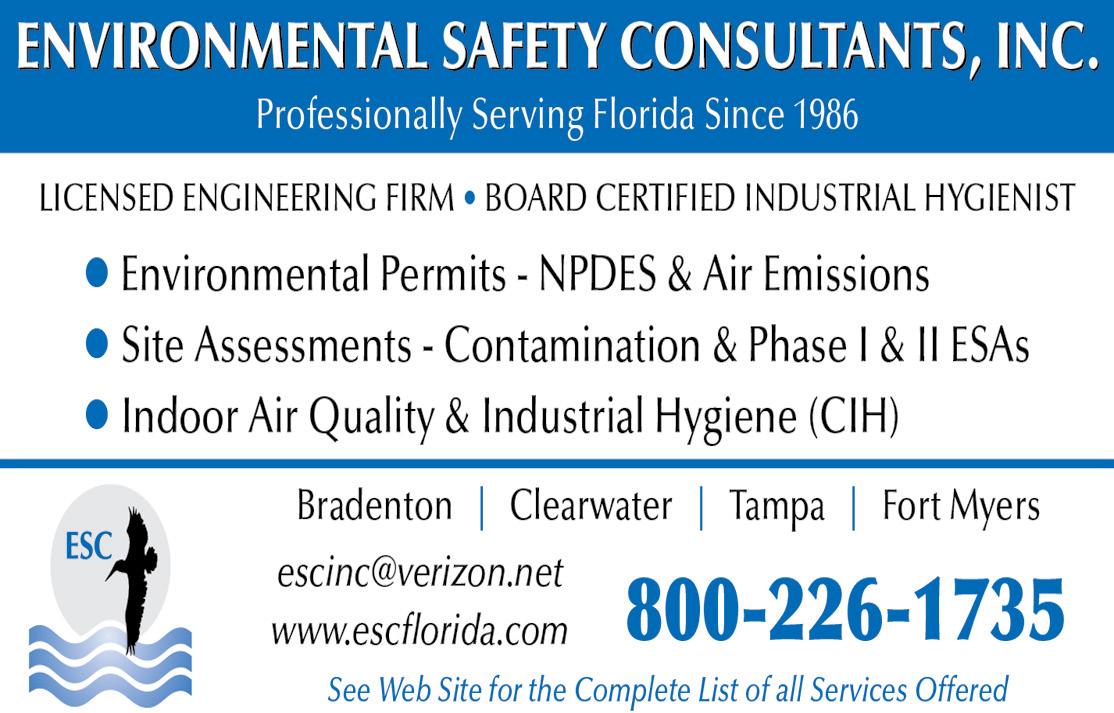
• 90+ pump stations
Approx. 3,537 hydrological monitoring stations at more than 687 flow sites, including 201 rain gauges and 22 weather stations.
The District continues to make significant infrastructure adaptation investments to carry out its mission of safeguarding and restoring Central and Southern Florida’s water resources and ecosystems, protecting communities from flooding, and ensuring an adequate water supply for all of South Florida’s needs.
Recently, the District, the U.S. Army Corps of Engineers (USACE), Miccosukee Tribe of Indians of Florida, and the Seminole Tribe of Florida celebrated the groundbreaking of the first major feature of the Western Everglades Restoration Project (WERP), the L-28 South Culverts.
The new culverts are part of the Comprehensive Everglades Restoration Plan (CERP) and will restore and reconnect Water Conservation Area 3A with Big Cypress National Preserve and Lostmans Slough. This project is located in an area of South Florida where Water Conservation Area 3, Big Cypress National Preserve and Everglades National Park as well as the Miccosukee Alligator Alley Reservation all intersect.
The goal of installing these culverts is to improve the timing and distribution of water to re-establish ecological connectivity and restore the natural hydrologic conditions in Big Cypress National Preserve and western Everglades National Park.
At the end of May here on the west coast, the District and the USACE, along with many state officials and stakeholders, celebrated the completion of an important component of the Picayune Strand Restoration Project. The plugging of a major canal, the Faka Union Canal, is now complete, marking another milestone on this project. It was one of the final components needed to accomplish the Picayune Strand Restoration Project’s goal of restoring the natural hydrology of over 55,000 acres of native wetlands and uplands on Florida’s Southwest coast. Three out of the four canals are now plugged.
This restoration project is expected to result in improved flows of water into Collier Seminole State Park, Ten Thousand Islands National Wildlife Refuge and the Rookery Bay National Estuarine Research Reserve. Some of the expected environmental benefits include:
• Restoration of wetlands that are already making a significant contribution to the landscape of Southwest Florida
• Restored and enhanced habitat for fish and wildlife, including the Florida Panther
• Reduced drainage of adjacent sensitive ecosystems
• Improved aquifer recharge to protect underground water supplies and prevent saltwater intrusions
• Reduced freshwater releases/ improved health of downstream estuaries
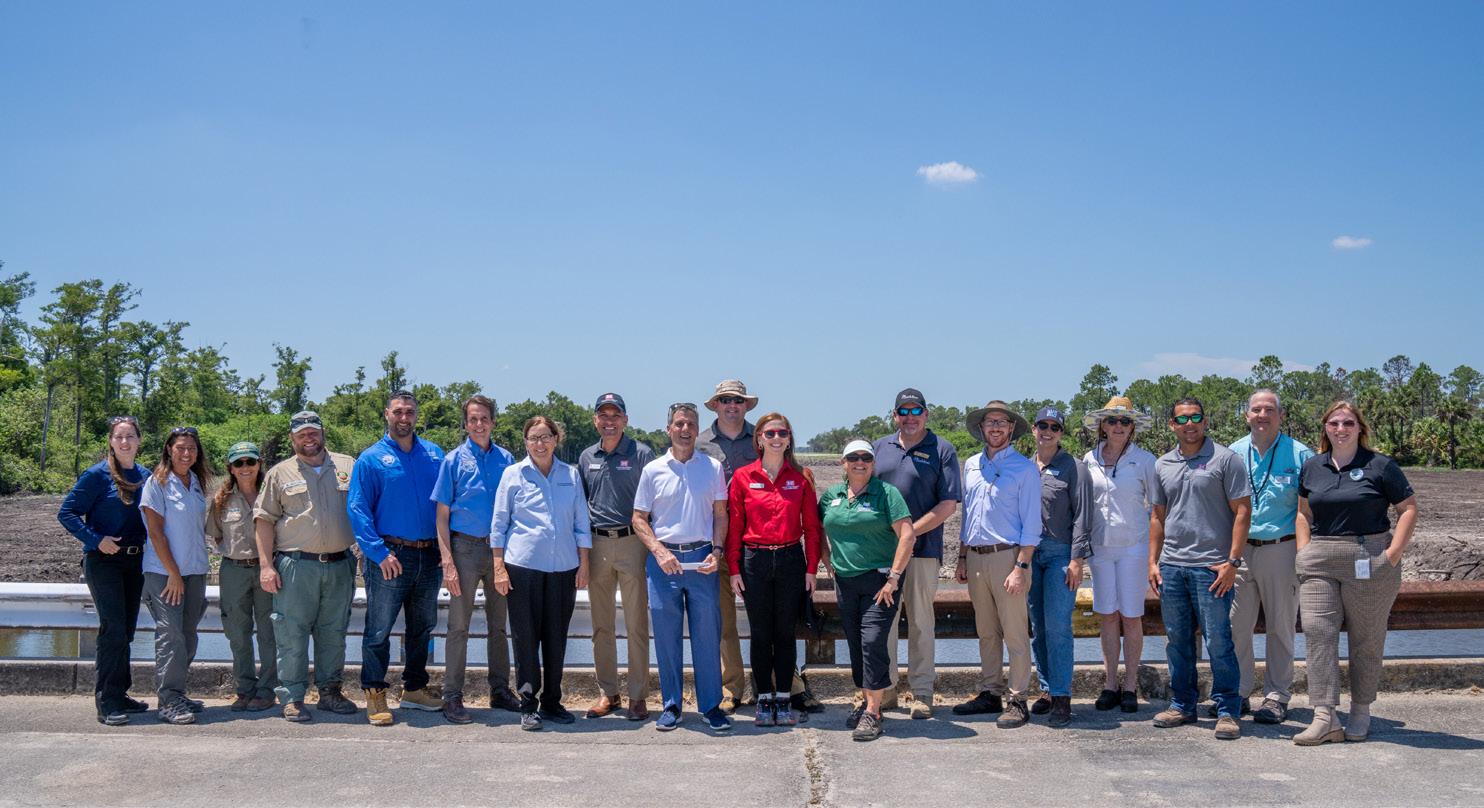
In 2009, the Picayune Strand Restoration Project was the first Project Partnership Agreement that the USACE executed with the District as part of the Comprehensive Everglades Restoration Plan (CERP). The project is expected to be completed by the end of 2025 with the plugging of the fourth canal. We are so close to completing this important Everglades project which will restore the hydration and ecosystem of this incredible national treasure. The Picayune Strand Restoration Project is near and dear to my heart, and I am so proud of the progress we are making on this project and all of the projects in South Florida.
The Lake Okeechobee System Operating Manual (LOSOM) Record of Decision was signed in August 2024. The USACE updated the Lake Okeechobee operations manual to define operations for the Lake Okeechobee regulation schedule. New lake level management will be implemented in a manner that reduces harmful discharges into the coastal estuaries, sends more water south to benefit the environment and meets the needs of the communities.
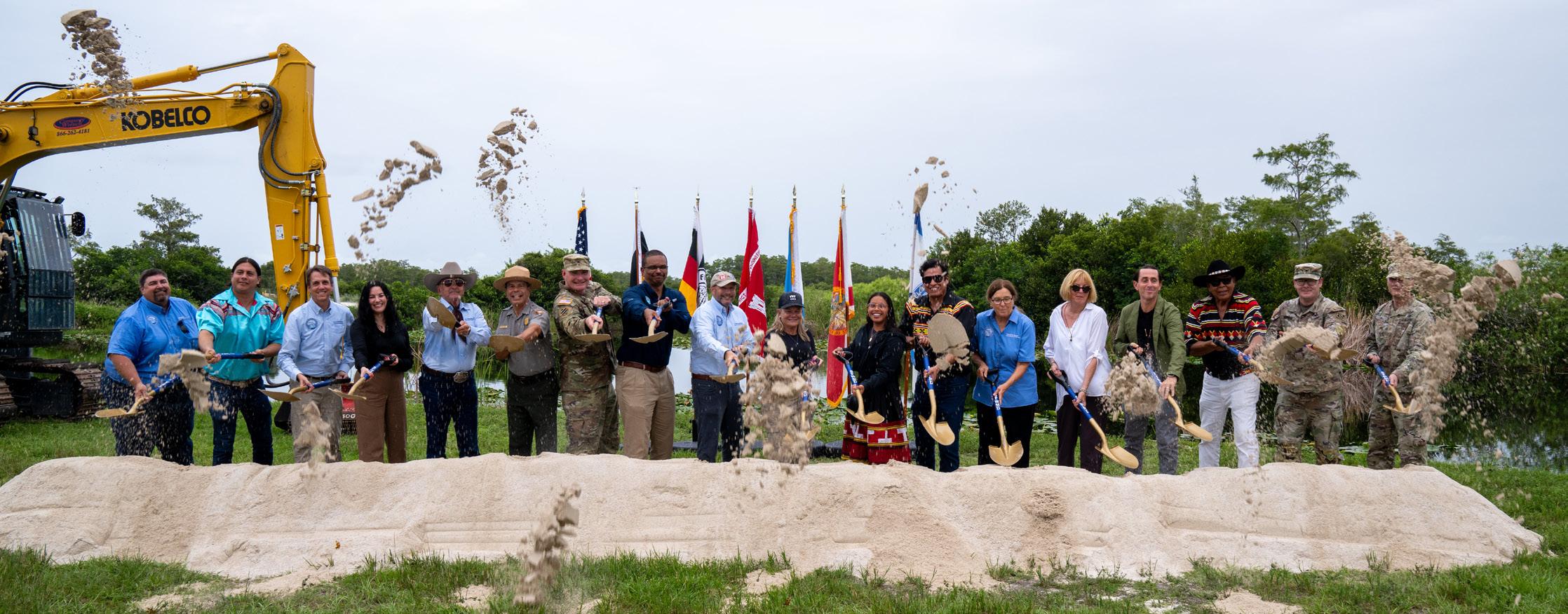

Our lawyers practice before federal, state, & local governmental authorities on environmental, water, land use & zoning, due diligence, wetland mitigation & water quality banking, public/private partnerships, affordable housing, licensing, and regulatory matters throughout Florida, as well as administrative and civil litigation related to those practice areas.
We work on full range of projects including residential, commercial, industrial, marina & agricultural projects before the Department of Environmental Protection, Water Management Districts, Army Corps of Engineers, and other regulatory agencies.
“Historic. Collaborative. Important,” said South Florida Water Management District Board Chairman Chauncey Goss in a statement. “We have worked for five years to get to the record of decision, and we are finally here. I’m proud of the South Florida Water Management District staff who worked with the team at the U.S. Army Corps of Engineers to ensure the Lake Okeechobee System Operating Manual (LOSOM) was implemented in a manner that reduces harmful discharges into our estuaries, sends more water south to benefit the environment and meets the needs of our communities. I want to thank everyone who engaged in this process over the years, especially all of our stakeholders and members of the public who contributed to its development every step of the way.”
The District has local partners, state partners, federal partners, tribal nations, stakeholders, members of the public, contractors and more all working together. We are continuing to see both small and incredible large-scale projects come online; and the beauty of it is…Everglades restoration is working!
New data demonstrates the success of restoration and resiliency projects across our region - proving recent investments and momentum are working. Record water flows and water depths in the Everglades coupled with rainfall demonstrated that restoration can support healthy salinity levels in Florida Bay. Balanced salinity supports sea grass and spawning fish. The graphic below shows water depths over the years in two key locations, Shark River Slough and Taylor Slough. The improvements in water depths over the past three years demonstrate that restoration projects and operations work well together to nourish the Everglades and send water south to support the health of Florida Bay.
I am honored to be a South Florida Water Management District Governing Board Member as we work on the largest ecosystem restoration effort on Earth. This is truly the “Golden Age of Everglades Restoration,” and with your help and support, we can keep this momentum moving forward for generations to come. ●
Charlette Roman is Chair of the Big Cypress Basin Board and Governing Board Member of the South Florida Water Management District
Visit our website at SFWMD.gov to learn more about the work of the South Florida Water Management District.
The District’s November Governing Board Meeting is scheduled for 9 a.m. Thursday, Nov. 14, 2024, in Hendry County at the John Boy Auditorium located at 1200 W.C. Owen Avenue, Clewiston, FL 33440. If you would like to attend, please visit SFWMD. gov/Meetings for more information.
By STAFF REPORTS
In the heart of North Florida, the Suwannee River Water Management District (SRWMD) is stewarding natural treasures with a dedication to safeguarding the delicate balance between conservation and flood protection. Through a comprehensive land management program, SRWMD employs various strategies, such as acquisition, timber harvests, prescribed fires, invasive treatment, rare species monitoring, and vegetation management to sustainably manage their lands.
This multifaceted approach supports the preservation of vital ecosystems while mitigating flood risks for communities. As members of the SRWMD management team emphasize, this harmonious approach to land management is crucial for a resilient and sustainable future.
The Crucial Role of Conservation
Conservation lies at the core of SRWMD’s mission. The District’s 160,000-acre holdings are not only home to diverse ecosystems but also serve as buffers against flooding during heavy rainfall and storms. Conserving these lands also helps preserve important habitats such as wetlands and flatwoods and assist in ecological restoration.
“Our land management practices are deeply intertwined with our commitment to conservation,” said District Executive Director Hugh Thomas. “By maintaining healthy ecosystems, we create natural spaces that act as sponges during heavy rainfall, reducing the impact of flooding on both communities and natural habitats.”
Timber Harvests: A Sustainable Approach
Timber harvests, when conducted responsibly, can contribute to both conservation and flood protection efforts. SRWMD employs selective timber harvesting practices that mimic natural disturbances, ensuring the long-term health of forests. This approach not only supports local economies but also encourages forest regeneration, enhancing the land’s ability to store water and prevent erosion.
“Our timber harvesting practices adhere to rigorous sustainability standards,” said Lorna Radcliff, Land Management Chief. “By carefully selecting areas for harvest and replanting, we promote a healthy forest ecosystem that plays a vital role in water retention and flood prevention.”
Prescribed Fire: Nurturing Ecosystems
Prescribed fires are a critical tool in SRWMD’s land management arsenal. These controlled burns mimic natural fire regimes, reducing the buildup of flammable vegetation and invigorating ecosystems. By restoring the balance of fire-adapted landscapes, SRWMD not only fosters biodiversity but also creates firebreaks that inhibit the spread of wildfires, ultimately protecting nearby communities.
On average, the District burns an average of 8,000 to 10,000 acres per year, depending on conditions.
Radcliff affirms that, “Prescribed fires are a testament to our commitment to ecological health and community safety. These

fires are carefully planned and executed to ensure that our lands remain resilient, while also preventing catastrophic wildfires that can threaten lives and property.”
Vegetation Management: A Comprehensive Approach
Effective vegetation management is crucial for flood protection. On thousands of acres each year, SRWMD employs techniques such as planting native vegetation, removing invasive exotic species, and controlling vegetation to improve natural communities while enhancing the land’s capacity to retain water and mitigate flood risks. These efforts are designed to maintain the delicate balance between water storage and flow regulation.
“Our vegetation management strategies are driven by the need to create natural buffers that slow down and retain excess water during heavy rainfall events,” Radcliff said. “This approach is essential for reducing the likelihood and impact of floods in vulnerable areas.”
Lands owned and managed by SRWMD provide habitat for numerous plant and animal species, including several rare and imperiled species. During the course of land management activities, it’s important to know how these activities affect the native, natural communities. The District is committed to actively monitoring several populations of imperiled biota in order to track population response to land management activities.
Challenges and Ongoing Commitment
The path to harmonizing conservation and flood protection is not without challenges. Balancing the needs of diverse ecosystems while safeguarding communities requires adaptive strategies and continuous innovation. SRWMD’s management team is keenly aware of these challenges and remains committed to refining their
land management practices in response to evolving circumstances.
“Adapting to changing conditions is a cornerstone of our mission,” Thomas said. “We are investing in research, partnering with experts, and leveraging cutting-edge technologies to refine our land management practices. This dedication ensures that our strategies remain effective in the face of emerging challenges.”
The Suwannee River Water Management District’s integrated approach to land management is a testament to their commit-
ment to conservation and flood protection. Through sustainable timber harvests, prescribed fires, and comprehensive vegetation management, SRWMD demonstrates that a harmonious coexistence between humans and nature is possible. As the management team underscores, this approach not only safeguards the environment but also contributes to the well-being of communities and the resilience of the region. By nurturing their lands today, SRWMD is forging a path toward a more sustainable and flood-resilient future for generations to come. ●






By KEYNA CORY
Each year, the Florida Recycling Partnership Foundation, and the Florida Department of Environmental Protection host Florida Recycles Day to shine a spotlight on the importance of recycling and its profound impact on both our economy and environment. The 2024 event will be held on Friday, Nov. 15 at the Patel College for Global Sustainability at the University of South Florida.

cling Economic Information (REI) Study in 2020. This study analyzes the numbers of jobs, wages and tax revenues attributed to recycling. The study found that in a single year, recycling and reuse activities in the United States accounted for:
• 681,000 jobs
• $37.8 billion in wages
• $5.5 billion in tax revenues
This equates to 1.17 jobs per 1,000 tons of materials recycled and $65.23 in wages and $9.42 in tax revenue for every ton of materials recycled. For more information, check out the full report
and Bud Light aluminum bottles, this project will create approximately 75 new jobs at the facility. MCC produces cans and lids for Anheuser-Busch products as well as major U.S. soft drink companies, including PepsiCo. and Monster Beverage Corporation. By investing in recycling infrastructure, Florida can enhance its economic resilience, reduce reliance on imported materials, and support sustainable job creation.
mitigate land use concerns, and minimize the environmental impact associated with waste disposal.
As we come together to recognize this initiative, it’s essential to understand why recycling matters and how it can drive positive change in our state.
Recycling is not just an environmental necessity; it’s also a significant economic driver. In Florida, the recycling industry supports thousands of jobs and generates millions in revenue.
EPA released significant findings on the economic benefits of the recycling industry with an update to the national Recy-
By diverting waste from landfills, we not only reduce disposal costs but also create a market for recyclable materials, which can lead to innovation and new business opportunities.
Moreover, the recycling sector promotes local manufacturing. Recycled materials can often be transformed into new products right here in Florida, which bolsters the local economy. Anheuser-Busch announced plans to invest $170 million in an expansion project at its Metal Container Corporation (MCC) facility in Jacksonville.
As part of the company’s plan to increase production of the popular Budweiser
The environmental advantages of recycling are equally compelling. Recycling conserves natural resources by reducing the need for raw materials. For example, recycling aluminum saves up to 95% of the energy required to produce new aluminum from bauxite ore. This energy savings translates into lower greenhouse gas emissions, helping combat climate change.
Each ton (2,000 pounds) of recycled paper can save 17 trees, 380 gallons of oil, three cubic yards of landfill space, 4,000 kilowatts of energy, and 7,000 gallons of water. This represents a 64 percent energy savings, a 58 percent water savings, and 60 pounds less of air pollution.
In addition, recycling reduces the volume of waste sent to landfills. Florida’s landfills are rapidly reaching capacity, and managing waste is becoming increasingly challenging. By promoting recycling, we can prolong the life of our landfills,
Florida Recycles Day also emphasizes the importance of community involvement and education. It serves as a reminder that everyone can play a role in creating a more sustainable future. Local governments, businesses, and residents can collaborate to enhance recycling efforts and promote responsible waste management practices. Many of them will be participating in our Florida Recycles Day in November!
Educational campaigns can help raise awareness about what can be recycled, how to do it correctly, and the benefits of reducing waste. By fostering a culture of sustainability, we empower individuals to make informed decisions that positively impact our environment and economy.
As we celebrate Florida Recycles Day, let’s commit to making recycling a priority in our daily lives. The benefits to our economy and environment are clear: recycling creates jobs, conserves resources, and reduces negative environmental impacts. Together, we can ensure that Florida leads the way in sustainability, creating a brighter future for generations to come. ●
Keyna Cory is the Executive Director for the Florida Recycling Partnership Foundation
By KEVIN DOYLE
As Florida continues to grow, so too does our energy demand. It’s always growing in parallel with our economic and population expansion, and so what happens after the presidential election is doubtlessly going to influence our state’s energy environment, economy and the living standards of Floridians.
Whether Vice President Kamala Harris or former President Donald Trump wins, their energy policies will have an impact in the Sunshine State. That means we will need every option available, from solar and wind power to traditional fuels like natural gas and emerging technologies such as advanced nuclear and hydrogen. They all have a role to play in our energy future. However, whomever occupies the White House will have an influence over
what sources are favored by the federal government.
If former President Donald Trump returns to office, we’ll see a renewed focus on developing traditional fuel sources, particularly oil and natural gas. This approach will benefit Florida, where natural gas currently supplies three-quarters of our electricity. Trump’s policies are likely to foster increased domestic production, which would lead to more stable and energy prices for Floridians and the rest of the nation.
Furthermore, Trump’s stated positions on energy infrastructure – especially pipelines – and his support to improve the process of permitting and environmental views, bode well for a similar performance in a second term. As Florida’s population continues to boom, we will need

additional infrastructure to meet rising energy demands.
On the other hand, a victory for Vice President Kamala Harris presents more questions than answers. While specifics are still a bit unclear, Harris will likely continue her legacy under the Biden Administration of transitioning away from traditional energy sources via regulation while championing renewable energy sources.
While this may help reduce our state’s carbon footprint, it presents challenges for affordable and reliable energy. For example, industrial scale solar has benefited our state, but it can be vulnerable to the tropical storms and hurricanes that are a fact of life here. A tornado tore through one solar field during Hurricane Milton, local TV showed, destroying scores of panels. And, relying solely on renewable power without sufficient dispatchable, always-available power like natural gas or nuclear presents significant potential issues on high demand days.
Harris’s approach to traditional fuels, particularly natural gas, will pose challenges for Florida. The Vice President made early campaign statements claiming she has changed her mind to now support hydraulic fracturing – and it was lost on no one that she said it in the swing state of Pennsylvania, which is the nation’s second largest natural gas producer. But later, the Vice President contradictorily said that she would not have done anything differently than President Biden – “and I’ve been part of most of the decisions that have had impact.”
Regardless of who wins, Florida faces unique energy challenges that demand attention. Our state’s rapid growth means
we’ll need to expand our energy infrastructure to keep pace with demand. This necessity exists independently of federal policy but will be either helped or hindered by the next administration’s approach.
Moreover, Florida’s vulnerability to hurricanes adds another layer of complexity to our energy considerations. We need resilient energy systems that can withstand extreme weather events. This requirement should be a priority for any administration to support, especially because it will increase our capability to harden critical energy infrastructure with federal funds – which have already paid off in many instances across the state when the weather has turned dangerous.
The economic implications of these potential energy shifts are significant. Our tourism industry, agriculture sector, and growing tech hubs all depend on reliable, affordable energy. Any changes to our energy mix or costs will ripple through these vital economic sectors, affecting job creation and economic growth.
Florida’s energy policies must prioritize reliability, affordability, and sustainable, resilient and environmentally sound options that are in harmony with our economic growth. The energy policies set forth by the White House matter to American families and businesses. Our energy future – and by extension, our state’s economic well-being – hangs in the balance so we need to choose carefully in November.
Kevin Doyle is Vice President of State Affairs and Southeast Executive Director for the Consumer Energy Alliance
By NORWIN VOEGELI

Coastal erosion presents a significant challenge to shorelines worldwide, impacting local communities, governments, researchers, and environmental planners. Rising sea levels and increasingly extreme weather events, such as hurricanes, exacerbate the need for effective coastal management and protective structures.
Traditional methods, such as rock armor and concrete revetments, have long been utilized, but innovative solutions, such as the TECCO Cell, offer enhanced protection against coastal erosion. TECCO Cell, a specially engineered system, consists of a steel mesh array filled with locally sourced materials including stones, blocks, and pebbles. This new technology provides a cost-effective and sustainable alternative for protecting shorelines.
Current Shore-Protection Systems
Traditional systems for coastal protection include:
Rock Armor/Rip Rap: Large boulders are strategically placed along shorelines with gentle slopes to dissipate wave energy and minimize erosion.
Precast Concrete Elements: Like rock armor, these elements are installed on shallow slopes to guard against wave action.
Gabions: Rectangular wire-mesh containers filled with rocks and stones, commonly used to absorb wave energy.

BOATING RESTRICTIONS IN EFFECT DUE TO HURRICANE MILTON
The Florida Fish and Wildlife Conservation Commission (FWC) is advising the public that several rivers across the state are currently experiencing significant flooding as a result of Hurricane Milton. The impacted rivers include the Suwannee/Santa Fe, St. Johns and Withlacoochee rivers. Flooding conditions along these rivers have led to the implementation of safety measures to protect the public.
As floodwaters rise, specific areas of these rivers have reached established flood levels, triggering Idle Speed/No Wake zones. These restrictions are enforced when NOAA and U.S. Geological Survey flood gauges indicate that water levels have reached critical points. Boaters navigating through these zones must reduce their speed to idle and ensure their wake does not create a hazard.
Due to extreme flooding, some sections of the Withlacoochee River are currently closed to all vessel traffic. This decision has been made for public safety as rising water levels can create dangerous conditions, such as submerged hazards, fast currents and debris, making navigation treacherous. Boaters are urged to avoid these areas entirely until water levels recede, and normal conditions are restored.
Concrete or Sheet Pile Seawalls: Vertical barriers installed on shorelines to act as a direct defense against wave erosion, often with anchors to prevent collapse.
Each solution has proven effective, but the choice of system depends on site-specific conditions, including:
• Material and transport costs
• Installation and maintenance expenses
• Service life and resistance to scour
• Dismantling or recycling requirements
The TECCO Cell Solution
Gabions have been a familiar sight in coastal defenses for decades. The TECCO Cell takes this concept further, utilizing high-tensile stainless steel (AISI 318 LN) wire mesh to create an array of cells. These cells are filled with locally sourced materials, offering a robust and flexible solution for coastal protection.
Key Installation Steps:
• Prepare the slope using an excavator.
• Install geosynthetics for separation and filtration as needed.
• Deploy the empty TECCO Cell array on the slope.
• Fill the cells with stones, blocks, and pebbles from the site.
• Secure the cells with clips and ropes.
• Add rock armor along the edges to prevent scour.
In 2016, TECCO Cell was installed at Beesands Beach in Devon, UK, following the failure of existing coastal defenses due to severe storms in 2014. The rock armor previously in place had been damaged, prompting local authorities
To ensure safety and compliance with these restrictions, the FWC strongly encourages all boaters to stay informed about current river conditions. For the most up-to-date information on Idle Speed/No Wake zones, river closures and other important alerts, visit MyFWC.com/ Boating, click on “Waterway Management” and then on the “Alert!” banner at the top of the page. ●
DEP ADDS MORE THAN 1,300 ACRES TO THE LITTLE BIG ECON STATE FOREST
The Florida Department of Environmental Protection announces the completion of the Yarborough Ranch Florida Forever Project with the recent purchase of a 1,361-acre property. Located in southeastern Seminole County, this property provides an important linkage in the Florida Wildlife Corridor to existing conservation lands, including the Little Big Econ State Forest.
“Adding to our network of conservation lands is always an occasion to celebrate,” said DEP Secretary Shawn Hamilton. “I once again thank Governor DeSantis for supporting our ambitious environmental goals with dedicated funding for the Florida Forever Program. Purchases like Yarborough Ranch will benefit our residents, visitors and wildlife by providing improved water quality, species habitat and recreational opportunities.”
The property is almost entirely within the Geneva Freshwater Lens, which provides drinking water for county residents. Conserving the property protects this unique and valuable hydrologic resource, helps to safeguard the health and diversity of the
to seek innovative solutions through public procurement. Working in collaboration with a local contractor, TECCO Cell was introduced as a custom-engineered solution for the shoreline.
An initial 20-meter stretch was completed, receiving approval from the UK Environment Agency. The installation proved successful, and in 2021, an additional 70 meters of coastline was secured with TECCO Cell. After Storm Darcy in 2021, the installation demonstrated resilience, with no visible damage or corrosion.
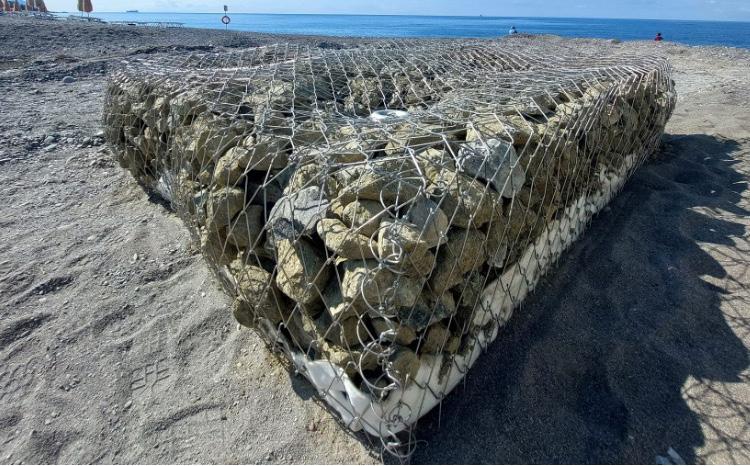
reducing the cost compared to traditional beach renourishment. The underlying TECCO Cell structure remains intact for decades, ensuring long-term protection against erosion.
Beyond traditional coastal erosion protection, TECCO Cell offers unique applications in Florida, where protecting delicate ecosystems is a priority. The modular nature of TECCO Cell allows for diverse uses, such as:
Artificial Reefs: TECCO Cell Mobile can be submerged underwater to act as an artificial reef, breaking waves before they reach the shoreline. When filled with limestone or similar rocks, TECCO Cell also serves as an ideal habitat for oysters, promoting marine biodiversity in areas like Florida’s Big Bend.
Natural-Looking Dunes: TECCO Cell installations can be covered with sand to mimic natural dunes, providing a surface suitable for pedestrian traffic and even turtle nesting. In the event of a storm, sand can be easily replaced, significantly
regional ecosystem, and prevents further development.
It will be managed by the Florida Forest Service as part of the Little Big Econ State Forest, which is open during daylight hours for visitors to enjoy hiking, canoeing, horseback riding, bicycling, wildlife viewing and picnicking. ●
COMMISSIONER WILTON
SIMPSON URGES USDA TO ISSUE DISASTER DECLARATION FOR HURRICANE MILTON DAMAGE
Florida Commissioner of Agriculture
Wilton Simpson sent a letter to the United States Secretary of Agriculture formally requesting a U.S. Department of Agriculture (USDA) Disaster Declaration for Florida counties impacted by Hurricane Milton. Hurricane Milton caused catastrophic damage to Florida’s agricultural producers, compounding losses and financial strain from previous storms. Based
Traditional TECCO Cell installation provides durable protection for roads, streets, railways, jetties, and much more. It can be applied in any location where rip rap is typically used, offering the significant advantage of requiring little to no maintenance for many years. TECCO Cell remains secure even after severe weather events like hurricanes, eliminating the need for post-storm rearrangement.
TECCO Cell presents an innovative and versatile solution to coastal erosion, combining the durability of traditional methods with enhanced adaptability. Its success in Beesands and potential applications in Florida highlights its value as a long-term, cost-effective approach to shoreline protection, ensuring sustainability in an era of rising sea levels and increasingly volatile weather patterns. ●
Norwin Voegeli is CEO of Global Ingress
on initial reporting and communication with farmers, the Florida Department of Agriculture and Consumer Services’ initial damage assessment estimates total losses to the agriculture industry between $1.5 billion and $2.5 billion.
“Hurricane Milton has left a broad path of devastation, impacting our farmers and threatening Florida’s position as a leading agricultural producer. With four major hurricanes in just over a year, our agriculture communities have been hit repeatedly, causing unprecedented financial strain,” said Commissioner Simpson. “We need the USDA’s immediate support to help these family farms recover from yet another historic storm. The time to act is now.”
In his letter to Secretary Tom Vilsack, Commissioner Simpson urged the USDA to expedite the review process and make all available assistance through the Farm Service Agency and other USDA programs accessible to farmers. ●


Houston area utility CenterPoint Energy announced plans to upgrade its power grid infrastructure in preparation for the 2025 hurricane season, following criticism of its response to Hurricane Beryl in July. The Houston-area electric utility aims to install 25,000 durable fiberglass or alternative material poles to replace some wooden ones by June 1, 2025. Additionally, the company plans to trim or remove vegetation along 4,000 miles of its approximately 30,000 miles of aboveground power lines. CenterPoint also intends to place more than 400 miles of power lines underground. Read more
The U.S. Supreme Court has agreed to hear a long-standing case regarding a plan to transport highly radioactive nuclear waste to a storage facility in rural West Texas, which could impact national waste management practices. Interim Storage Partners has sought to move “high-level” nuclear waste from various power plants to the facility in Andrews County but faced legal challenges after a Texas-led lawsuit blocked their federal license. This decision was upheld by a federal appeals court, prompting the company and the Nuclear Regulatory Commission (NRC) to petition the Supreme Court for reconsideration. The central issue is whether federal regulators can authorize privately operated nuclear waste storage sites located far from the waste’s source, with potential implications for a similar project in New Mexico. Opponents of the Texas plan, including local oil and ranching interests, argue it poses risks to the region, while supporters insist that federal law grants the NRC authority to approve such facilities. The case reflects a decades-long struggle for U.S. administrations to find a permanent solution for managing dangerous nuclear waste, with the proposed facilities viewed as temporary solutions that could last for years. Read more
Constellation Energy’s proposal to build a new 300-megawatt power plant near existing plants in Granbury that border residential neighborhoods is facing opposition from residents. Concerns are amplified by the presence of Marathon Digital, a cryptocurrency company operating a 300-megawatt Bitcoin mine on the same site, which has generated complaints about constant noise from cooling fans associated with mining operations since the mine opened in 2022. Read more
Texas is nearing the adoption of revised oil and gas waste management rules for the first time since 1984, as the Railroad
Commission of Texas has announced a draft rule aimed at regulating various disposal sites for oil and gas drilling wastes. This includes managing materials such as drilling mud, sludge, cuttings, and produced water, which can be highly toxic. The rule-making process was accomplished through a task force comprising oil industry members and consultants providing recommendations over two years. The Railroad Commission solicited public comment on the revised draft until October 15. Read more
The Louisiana Future Energy Center, comprising 25 partner organizations focused on clean energy, has announced 40 projects that are expected to create more than 26,000 jobs and attract $60 billion in capital investment over the next five years. A legislative task force is exploring the importance of clean hydrogen for the state’s economy and aims to draft supportive legislation. The task force’s discussions emphasized that the energy transition is already underway, with more than one-third of Gulf Coast manufacturing investments in 2023 directed toward fuel adaptation for decarbonization. Jobs in refining and chemical manufacturing have increased by 2.8 percent from the previous year, with opportunities in clean energy plants outpacing those in upstream oil and gas by over 10,000 positions. Research was presented that highlighted the significant hydrogen demand for exports, electricity, and manufacturing, noting that Louisiana needs to prepare for the impacts of decarbonization policies and position itself as a global hydrogen exporter. Read more
Louisiana State University researchers are set to drill a deep carbon sequestration well near Tiger Stadium in Baton Rouge as part of a project aimed at establishing Louisiana as a hub for carbon capture technology. The well, scheduled for completion by 2025, will be located at LSU’s Petroleum Engineering Research, Training and Testing Lab, and will be used to test safety and monitoring technologies related to carbon sequestration. Funding for the project is partly sourced from federal and state dollars, along with contributions from Halliburton and ExxonMobil. Read more
The Louisiana Department of Energy & Natural Resources (DENR) is revamping its oilfield restoration program in response to the issue of orphaned (abandoned oil and gas) wells, with an estimated 4,700 such sites needing plugging. New DENR Secretary Tyler Gray, appointed by Governor Jeff Landry, acknowledged that the previous program, the Louisiana Oilfield Restoration Association (LORA), was ineffective in achieving its goals. State law previously limited Gray’s oversight of the Office of Conservation, restricting his ability to address LORA’s shortcomings. Recent legislation enhances the agency’s authority over the conservation office and lead to creation of the Louisiana Natural Resources Trust Authority, which will oversee financial security measures for drillers. The changes aim to ensure that operators have the financial means to maintain their wells and prevent future orphaned sites. Read more
The Louisiana Department of Energy and Natural Resources has announced a $249 million investment for the Louisiana Hubs for Energy Resilient Energy Operation program, funded by the Bipartisan Infrastructure Law’s Grid Resilience and Innovation Partnerships Program. The initiative aims to improve the reliability of energy sources and create “hubs” that provide essential services, such as charging stations and air conditioning, during outages. The program will be implemented over eight years, allowing time to identify effective projects, with costs shared among partners. Read more
The Mississippi Department of Environmental Quality (MDEQ) has fined the UK-based company Drax $225,000 for air emissions violations at its wood pellet plant in Gloster, which emitted hazardous air pollutants (HAPs) beyond its permitted limits in 2022, including 84 percent more methanol. This marks the third fine for Drax since the plant’s opening in 2016, following a $2.5 million penalty in 2020 for significant violations of volatile organic compounds and a $110,000 fine in 2019 for recordkeeping issues. The current fine requires Drax to pay $150,000 directly to MDEQ and use $75,000 to construct a dust suppression screen, to address community concerns about dust pollution. Read more
Stakeholders convened at Mississippi State University for the inaugural Pathways to Resilience Summit, focusing on enhancing Mississippi’s resilience to environmental and man-made threats. The event, organized by MSU’s Office of Research and Economic Development and other partners, featured insights from academia, government, and private industry. Keynote speaker Narcisa Pricope emphasized the importance of environmental security for national security, while Mississippi Secretary of State Michael Watson advocated for a unified conservation approach that considers entire ecosystems. Speakers highlighted the interconnectedness of local and global challenges, including how advancements in artificial intelligence and geospatial technologies are improving predictions and responses to environmental scenarios. Participants also explored the potential for Mississippi to pursue a Sentinel Landscape designation to promote sustainable land use practices near military installations. Read more
A $366 million project by the U.S. Army Corps Engineers to deepen and widen the Mobile Bay shipping channel for larger cargo ships is being challenged in court by environmental groups, including Mobile Baykeeper and the Center for Biological Diversity. The project involves dredging 30 million cubic yards of sediment, much of which is planned to be dumped in the bay, potentially threatening vital oyster reefs and the livelihoods of local fishermen. While more than half of the dredged material is designated for beneficial uses
such as wetlands restoration, these groups are advocating for the remaining sediment to be deposited further offshore to safeguard essential habitats such as oyster reefs and seagrass beds. Read more
Bluestone Coke Plant Owner Subject of Clean Water Act Lawsuit
Jay ustice, son of West Virginia Governor and U.S. Senate candidate Jim Justice, failed to appear at a federal court hearing regarding a Clean Water Act lawsuit against Bluestone Coke, the company he leads. The presiding judge issued an order declaring Justice and Bluestone in civil contempt for not adhering to court directives. The lawsuit alleges that the idled coking plant in north Birmingham is polluting groundwater and nearby creeks with harmful runoff, including various pollutants. Plaintiffs Black Warrior Riverkeeper and GASP are seeking a court order to halt these discharges and impose civil fines on Bluestone. The affected neighborhoods are part of a designated Superfund site due to severe contamination. Coke production, while essential for steel manufacturing, generates pollution and waste, contributing to health risks for local residents. Read more
A 52-year-old coal miner, Jose Antonio M. Lara, died in September due to injuries sustained from a rock collapse at the Oak Grove mine in Jefferson County. His death, which marks the ninth U.S. coal mining fatality of 2024 and the first in Alabama, follows a series of safety violations at Oak Grove, including issues related to roof and rock collapses. In the month prior to Lara’s death, the mine was cited 89 times for safety violations, with 34 deemed “significant and substantial.” United Mine Workers of America safety experts are currently investigating the circumstances surrounding his death, while operations at the mine have been halted. Read more
U.S. Top Greenhouse Gas Emitter for Nine Consecutive Years Named
The James H. Miller Jr. Electric Generating Plant in West Jefferson has been identified as the top greenhouse gas emitter in the U.S. for the ninth consecutive year, releasing almost 16.6 million tons of greenhouse gases in 2023, according to the U.S. EPA. This amount surpasses the second-place emitter, Missouri’s Labadie Power Plant, by approximately 1.2 million tons. Alabama Power has not announced plans to retire or convert any units at Plant Miller. According to the EPA, power plants were the country’s largest source of planet-warming gases, with 1,320 plants releasing about 1.5 billion tons of CO2 equivalent. Read more
